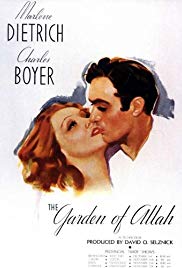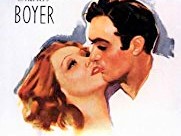The Garden of Allah *** (1936, Marlene Dietrich, Charles Boyer, Basil Rathbone, Tilly Losch, Joseph Schildkraut, Alan Marshal, C Aubrey Smith, John Carradine, Lucile Watson, Henry Brandon) – Classic Movie Review 7452
Director Richard Boleslawski’s 1936 The Garden of Allah is a remake of Rex Ingram’s 1927 silent romance The Garden of Allah, this time starring Marlene Dietrich as jaded hostess Domini Enfilden, who falls for runaway monk Boris Androvsky (Charles Boyer) in Algeria. It was only the fifth film to be photographed in Three-strip Technicolor. It won an Honorary Academy Award for its colour cinematography (W Howard Greene and Harold Rosson) and was nominated for two Oscars: Best Assistant Director (Eric Stacey) and Best Music, Score (Max Steiner).
It boasts a truly vintage cast. The exotic types lurking around Dietrich and Boyer include Basil Rathbone as Count Ferdinand Anteoni, Joseph Schildkraut as servant Batouch, Tilly Losch as dancer Irena, Alan Marshal as legionnaire Captain De Trevignac, C Aubrey Smith as the priest Father J Roubier, John Carradine as the Sand Diviner, Lucile Watson as Mother Superior Josephine, and Henry Brandon as the sheikh Hadj.
Based on the 1905 novel by Robert S Hichens, with a screenplay written by William P Lipscomb and Lynn Riggs, producer David O Selznick’s extravagant trifle is a relic from another far-off age as a throwback to silent movies.
The Garden of Allah is grandiose, bizarre and kitsch – and very entertaining on that level – but it is none too distinguished as the serious drama it seems to have set out to be. The stars, desert locations and W Howard Greene and Harold Rosson’s Honorary Academy Award-winning Technicolor cinematography are immensely eye-catching though, Max Steiner’s music score is stirring and that marvellous support cast has just got to be worth checking out.
The Garden of Allah also features Helen Jerome Eddy, Charles Waldron, John Byran, Nigel de Brulier, Pedro de Corboba, Ferdinand Gottschalk, Bonita Granville, Frank Puglia, Russ Powell, Louis Mercier, Andrew McKenna, Michael Mark, Henry Kleinbach, Leonid Kinskey, Marcia Mae Jones, Irene Franklin, Ann Bupp and Harlan Briggs.
Despite the stars, it flopped. It went over its $1.6 million by $370,000, about the size of the loss it recorded. But it was a hit in Brazil, where they named a Rio de Janeiro park after the movie.
Location shooting took place in Buttercup, California and Yuma, Arizona. So some of the exteriors were shot in the burning heat of the southwestern American desert and Boleslawski unwisely drank unboiled water rather than soft drinks and bottled water.
It proved the Polish director’s final finished movie. He died of a heart attack in 1937 at 47 while making The Last of Mrs Cheyney (1937) with Joan Crawford.
Boleslaw Ryszard Srzednicki changed his name to Boleslawski, though was often known as Boley. His most important films are Rasputin and the Empress (1932), Men in White (1934) with Clark Gable and Myrna Loy, The Painted Veil (1934) with Greta Garbo, Les Misérables (1935) with Fredric March and Charles Laughton and Theodora Goes Wild (1936).
Cyndi Lauper watches the film at the start of her Eighties classic ‘Time after Time’ music video.
© Derek Winnert 2018 Classic Movie Review 7452
Check out more reviews on http://derekwinnert.com



